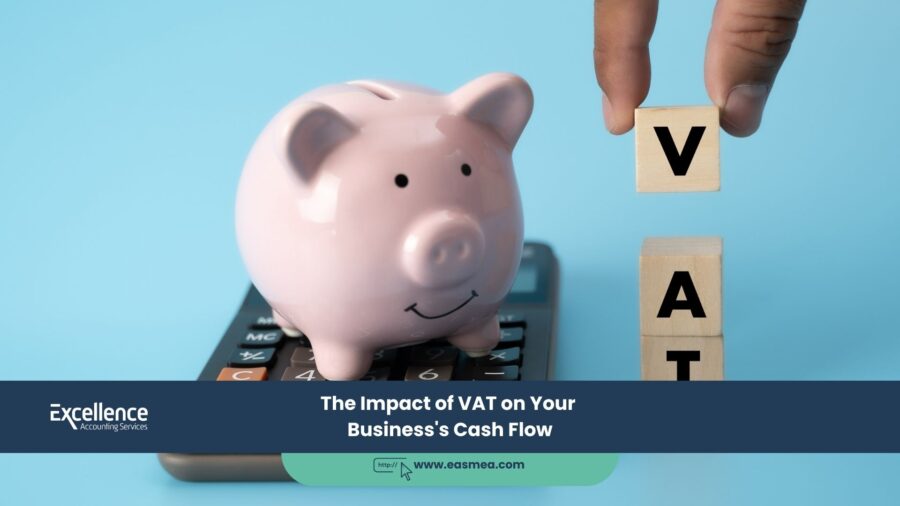A Business Owner’s Guide: The Impact of VAT on Your Cash Flow
For many businesses in the UAE, Value Added Tax (VAT) is viewed as a simple compliance task: charge 5% on sales, claim back 5% on costs, and pay the difference to the government. While this is true in principle, this simplistic view masks a critical and often painful reality: VAT can have a profound and negative impact on your business’s **cash flow**. The timing differences between when you have to pay VAT and when you actually receive it from your customers can create a significant cash squeeze, especially for growing businesses.
- A Business Owner's Guide: The Impact of VAT on Your Cash Flow
- The Fundamental Concept: Your Business as a Tax Collector
- The VAT Cash Flow Gap Explained
- Key Factors That Widen the Cash Flow Gap
- Managing Your VAT Cash Flow with Excellence Accounting Services (EAS)
- Frequently Asked Questions (FAQs)
- Don't Let VAT Squeeze Your Cash Flow.
Understanding and managing the cash flow implications of VAT is not just good financial practice; it is essential for survival. A profitable business on paper can be pushed into a liquidity crisis if its cash is tied up in the VAT system. The key is to recognize that you are acting as an unpaid tax collector for the government, and the money you collect is never truly yours.
This guide will provide a deep dive into the impact of VAT on your business’s cash flow. We will explain the concept of the “VAT cash flow gap,” analyze the key factors that influence it, and provide strategies for effective management.
Key Takeaways
- You are a Tax Collector: The VAT you collect from customers is a liability to the government, not your revenue. It must be managed as a separate pool of funds.
- The VAT Cash Flow Gap: This is the crucial timing difference. You often have to pay VAT to the FTA before you have collected the corresponding VAT from your customers, creating a cash shortfall.
–
Credit Terms are a Major Factor:
- Offering long payment terms to customers while having short terms with your suppliers is the primary driver of a negative VAT cash flow gap.
- Bad Debts Exacerbate the Problem: You are liable to pay output VAT on an invoice even if your customer never pays you. Recovering this VAT through bad debt relief is a lengthy process.
- Proactive Management is Essential: Effective cash flow management requires you to forecast your VAT payments and actively manage your receivables and payables. This is a core competency of strategic CFO services.
The Fundamental Concept: Your Business as a Tax Collector
The first and most important mindset shift is to understand that the output VAT you charge on your sales invoices does not belong to you. It is a trust tax. You are simply collecting it on behalf of the Federal Tax Authority (FTA). When you receive a payment of AED 10,500 (AED 10,000 + 500 VAT) from a customer, only the AED 10,000 is your revenue. The AED 500 is a liability that sits on your balance sheet until you remit it to the FTA.
Treating this collected VAT as your own working capital is one of the most dangerous financial mistakes a business can make. It creates a false sense of liquidity that vanishes when the VAT payment deadline arrives.
The VAT in your bank account is not your cash. It’s a temporary loan from the government that must be repaid on time.
The VAT Cash Flow Gap Explained
The core of the problem lies in the timing mismatch between your cash inflows and outflows related to VAT. Let’s illustrate with a simple example:
- Day 1: You purchase raw materials for AED 50,000 + 2,500 VAT. Your supplier gives you 30-day payment terms.
- Day 30: You pay your supplier the full AED 52,500. **Cash Outflow: AED 2,500 (Input VAT)**.
- Day 45: You sell the finished goods to a customer for AED 80,000 + 4,000 VAT. You give your customer 60-day payment terms.
- Day 90 (End of Quarter): Your quarterly VAT return is due. Your VAT payable is AED 1,500 (4,000 Output VAT – 2,500 Input VAT). You must pay this to the FTA. **Cash Outflow: AED 1,500 (VAT Payment)**.
- Day 105: Your customer finally pays you AED 84,000. **Cash Inflow: AED 4,000 (Output VAT)**.
In this scenario, you had to pay out a total of AED 4,000 in VAT (2,500 to your supplier and 1,500 to the FTA) before you received a single dirham of VAT from your customer. You have funded the government’s tax revenue out of your own working capital for a significant period. This is the VAT cash flow gap.
Key Factors That Widen the Cash Flow Gap
1. Credit Terms
As the example shows, the single biggest factor is the difference between your accounts receivable days and your accounts payable days. The longer you take to get paid by your customers, and the quicker you have to pay your suppliers, the wider the gap becomes.
2. Bad Debts
The situation becomes even worse if a customer defaults on their payment. You are required to account for output VAT based on the date of supply (usually the invoice date). This means you have to pay the output VAT to the FTA for that invoice, even if you never receive the money from your client. While there is a mechanism called **Bad Debt Relief** that allows you to reclaim this VAT, you can only do so after the debt has been written off and at least 6 months have passed since the invoice date.
3. Large Upfront Project Costs
For businesses like contractors, you may incur significant upfront costs for materials and subcontractors, paying out large amounts of input VAT. If you only bill your client based on project milestones, there can be a long delay before you start collecting output VAT to offset those initial cash outflows.
Managing Your VAT Cash Flow with Excellence Accounting Services (EAS)
Proactive cash flow management is essential for navigating the complexities of VAT. EAS provides the strategic financial guidance to help you stay liquid and compliant.
- Cash Flow Forecasting: Our CFO services include the development of detailed cash flow forecasts that specifically model your upcoming VAT payments, giving you advance warning of any potential shortfalls.
- Working Capital Optimization: We analyze your entire working capital cycle and provide strategic advice on managing your accounts receivable and accounts payable to minimize the VAT cash flow gap.
- Expert VAT Advisory: Our VAT consultants can provide guidance on complex issues like bad debt relief and the timing of supply to ensure you are managing your VAT obligations in the most cash-efficient way possible.
- Professional Bookkeeping: Our accounting and bookkeeping services ensure you have the accurate, real-time data needed to monitor your VAT position and manage your cash flow effectively.
Frequently Asked Questions (FAQs)
This is extremely risky and not recommended. While the money is in your bank account, it is technically a liability owed to the government. Using it for operational expenses can lead to a severe cash shortfall when the VAT payment deadline arrives. It’s best practice to segregate these funds, either mentally or in a separate bank account.
The Cash Accounting Scheme is an optional scheme for small businesses (with annual turnover under AED 5 million) that allows them to account for VAT based on when cash is actually paid and received, rather than on the invoice date. This can significantly help to eliminate the VAT cash flow gap, but you must be approved by the FTA to use it.
The penalties for late payment are severe. There is an initial penalty, and then a daily penalty accrues on the outstanding amount. The FTA is generally not lenient on penalties due to a business’s internal cash flow issues.
This can have a positive short-term effect. When you make a large, VAT-able purchase, you incur a significant amount of input tax. This can be reclaimed on your next VAT return and may result in a net VAT refund from the FTA, providing a temporary cash injection.
The FTA aims to process refunds within 20 business days of the application, but this can be longer if they decide to review or audit the claim. You should not rely on a refund arriving on a specific date for your critical cash flow planning.
A good accounting system with real-time data is key. You should regularly run a report (like a Taxable Sales/Purchases report) to see your running total of output tax collected and input tax incurred. This will give you a clear estimate of your liability for the upcoming VAT return.
Yes. Receiving an advance payment creates a “date of supply.” You must account for the output VAT on that advance in the tax period you receive the cash, even if you haven’t issued the final invoice or delivered the service yet.
It is a mechanism that allows you to recover the output VAT you paid to the FTA on an invoice that a customer never paid. To be eligible, you must have written off the debt in your books, and at least 6 months must have passed from the invoice date.
Yes. The VAT is calculated on the discounted price. If you offer a discount for early payment, you should issue a tax credit note to the customer to adjust the original VAT amount once they have taken advantage of the discount.
The FTA may, in exceptional circumstances, allow a taxpayer to pay their liability in installments, but this is not a standard procedure and requires a formal application and approval process. It should not be relied upon as a cash flow management strategy.
Conclusion: Proactive Management is the Only Solution
VAT is a permanent feature of the UAE’s business landscape, and so are its effects on cash flow. Ignoring these effects is a path to financial distress. The only solution is proactive management. By understanding the dynamics of the VAT cash flow gap, actively managing your credit terms, and maintaining disciplined financial planning, you can mitigate the negative impacts of VAT and ensure your business remains liquid, compliant, and healthy.
Don't Let VAT Squeeze Your Cash Flow.
Contact Excellence Accounting Services for a comprehensive review of your cash flow and VAT processes.




